Analysis of Efficient Market Hypothesis and Investment Environment
VerifiedAdded on 2021/09/18
|8
|3249
|35
Homework Assignment
AI Summary
This assignment explores the Efficient Market Hypothesis (EMH) and its implications for investment strategies. It delves into the random walk theory, technical analysis, and fundamental analysis, providing a comprehensive overview of market efficiency. The document explains weak, semi-strong, and strong forms of the EMH, illustrating concepts with practical examples. It also covers intrinsic value, abnormal returns, cumulative abnormal returns, and market anomalies. Furthermore, it discusses the investment environment, including real assets, fixed-income securities, equity, and derivative securities, and touches upon the agency problem. The content is designed to enhance understanding of financial markets and investment principles.
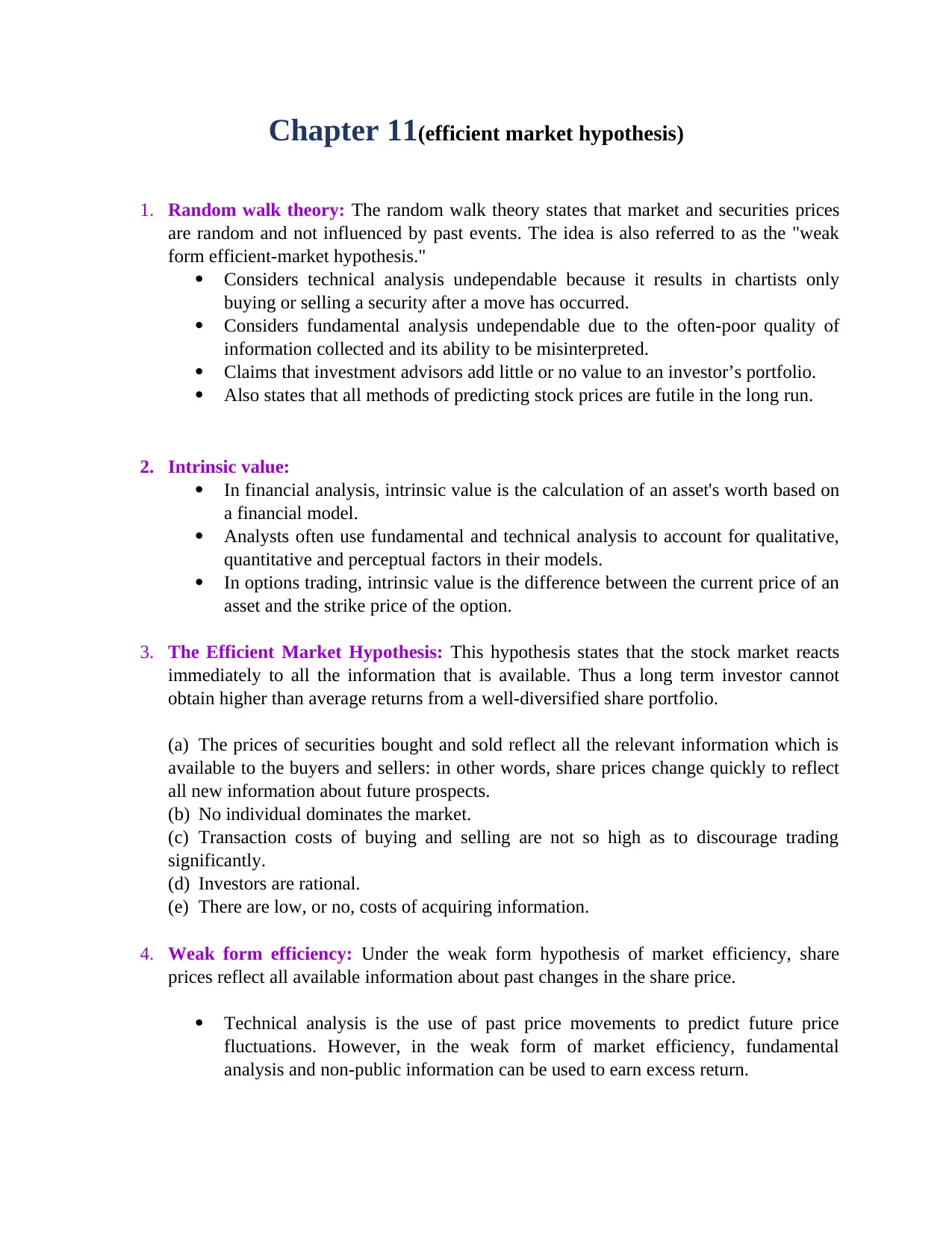
Chapter 11(efficient market hypothesis)
1. Random walk theory: The random walk theory states that market and securities prices
are random and not influenced by past events. The idea is also referred to as the "weak
form efficient-market hypothesis."
Considers technical analysis undependable because it results in chartists only
buying or selling a security after a move has occurred.
Considers fundamental analysis undependable due to the often-poor quality of
information collected and its ability to be misinterpreted.
Claims that investment advisors add little or no value to an investor’s portfolio.
Also states that all methods of predicting stock prices are futile in the long run.
2. Intrinsic value:
In financial analysis, intrinsic value is the calculation of an asset's worth based on
a financial model.
Analysts often use fundamental and technical analysis to account for qualitative,
quantitative and perceptual factors in their models.
In options trading, intrinsic value is the difference between the current price of an
asset and the strike price of the option.
3. The Efficient Market Hypothesis: This hypothesis states that the stock market reacts
immediately to all the information that is available. Thus a long term investor cannot
obtain higher than average returns from a well-diversified share portfolio.
(a) The prices of securities bought and sold reflect all the relevant information which is
available to the buyers and sellers: in other words, share prices change quickly to reflect
all new information about future prospects.
(b) No individual dominates the market.
(c) Transaction costs of buying and selling are not so high as to discourage trading
significantly.
(d) Investors are rational.
(e) There are low, or no, costs of acquiring information.
4. Weak form efficiency: Under the weak form hypothesis of market efficiency, share
prices reflect all available information about past changes in the share price.
Technical analysis is the use of past price movements to predict future price
fluctuations. However, in the weak form of market efficiency, fundamental
analysis and non-public information can be used to earn excess return.
1. Random walk theory: The random walk theory states that market and securities prices
are random and not influenced by past events. The idea is also referred to as the "weak
form efficient-market hypothesis."
Considers technical analysis undependable because it results in chartists only
buying or selling a security after a move has occurred.
Considers fundamental analysis undependable due to the often-poor quality of
information collected and its ability to be misinterpreted.
Claims that investment advisors add little or no value to an investor’s portfolio.
Also states that all methods of predicting stock prices are futile in the long run.
2. Intrinsic value:
In financial analysis, intrinsic value is the calculation of an asset's worth based on
a financial model.
Analysts often use fundamental and technical analysis to account for qualitative,
quantitative and perceptual factors in their models.
In options trading, intrinsic value is the difference between the current price of an
asset and the strike price of the option.
3. The Efficient Market Hypothesis: This hypothesis states that the stock market reacts
immediately to all the information that is available. Thus a long term investor cannot
obtain higher than average returns from a well-diversified share portfolio.
(a) The prices of securities bought and sold reflect all the relevant information which is
available to the buyers and sellers: in other words, share prices change quickly to reflect
all new information about future prospects.
(b) No individual dominates the market.
(c) Transaction costs of buying and selling are not so high as to discourage trading
significantly.
(d) Investors are rational.
(e) There are low, or no, costs of acquiring information.
4. Weak form efficiency: Under the weak form hypothesis of market efficiency, share
prices reflect all available information about past changes in the share price.
Technical analysis is the use of past price movements to predict future price
fluctuations. However, in the weak form of market efficiency, fundamental
analysis and non-public information can be used to earn excess return.
Paraphrase This Document
Need a fresh take? Get an instant paraphrase of this document with our AI Paraphraser
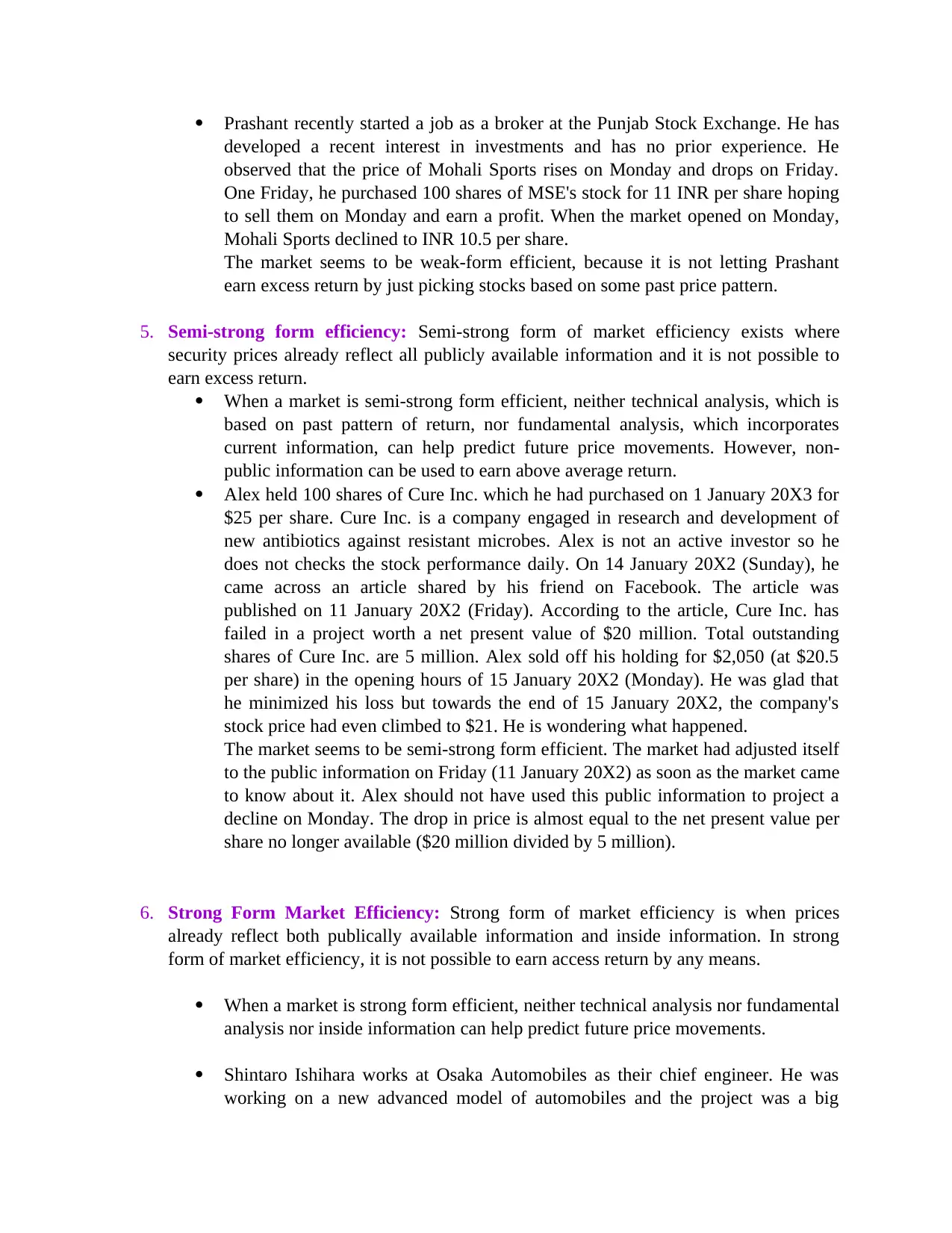
Prashant recently started a job as a broker at the Punjab Stock Exchange. He has
developed a recent interest in investments and has no prior experience. He
observed that the price of Mohali Sports rises on Monday and drops on Friday.
One Friday, he purchased 100 shares of MSE's stock for 11 INR per share hoping
to sell them on Monday and earn a profit. When the market opened on Monday,
Mohali Sports declined to INR 10.5 per share.
The market seems to be weak-form efficient, because it is not letting Prashant
earn excess return by just picking stocks based on some past price pattern.
5. Semi-strong form efficiency: Semi-strong form of market efficiency exists where
security prices already reflect all publicly available information and it is not possible to
earn excess return.
When a market is semi-strong form efficient, neither technical analysis, which is
based on past pattern of return, nor fundamental analysis, which incorporates
current information, can help predict future price movements. However, non-
public information can be used to earn above average return.
Alex held 100 shares of Cure Inc. which he had purchased on 1 January 20X3 for
$25 per share. Cure Inc. is a company engaged in research and development of
new antibiotics against resistant microbes. Alex is not an active investor so he
does not checks the stock performance daily. On 14 January 20X2 (Sunday), he
came across an article shared by his friend on Facebook. The article was
published on 11 January 20X2 (Friday). According to the article, Cure Inc. has
failed in a project worth a net present value of $20 million. Total outstanding
shares of Cure Inc. are 5 million. Alex sold off his holding for $2,050 (at $20.5
per share) in the opening hours of 15 January 20X2 (Monday). He was glad that
he minimized his loss but towards the end of 15 January 20X2, the company's
stock price had even climbed to $21. He is wondering what happened.
The market seems to be semi-strong form efficient. The market had adjusted itself
to the public information on Friday (11 January 20X2) as soon as the market came
to know about it. Alex should not have used this public information to project a
decline on Monday. The drop in price is almost equal to the net present value per
share no longer available ($20 million divided by 5 million).
6. Strong Form Market Efficiency: Strong form of market efficiency is when prices
already reflect both publically available information and inside information. In strong
form of market efficiency, it is not possible to earn access return by any means.
When a market is strong form efficient, neither technical analysis nor fundamental
analysis nor inside information can help predict future price movements.
Shintaro Ishihara works at Osaka Automobiles as their chief engineer. He was
working on a new advanced model of automobiles and the project was a big
developed a recent interest in investments and has no prior experience. He
observed that the price of Mohali Sports rises on Monday and drops on Friday.
One Friday, he purchased 100 shares of MSE's stock for 11 INR per share hoping
to sell them on Monday and earn a profit. When the market opened on Monday,
Mohali Sports declined to INR 10.5 per share.
The market seems to be weak-form efficient, because it is not letting Prashant
earn excess return by just picking stocks based on some past price pattern.
5. Semi-strong form efficiency: Semi-strong form of market efficiency exists where
security prices already reflect all publicly available information and it is not possible to
earn excess return.
When a market is semi-strong form efficient, neither technical analysis, which is
based on past pattern of return, nor fundamental analysis, which incorporates
current information, can help predict future price movements. However, non-
public information can be used to earn above average return.
Alex held 100 shares of Cure Inc. which he had purchased on 1 January 20X3 for
$25 per share. Cure Inc. is a company engaged in research and development of
new antibiotics against resistant microbes. Alex is not an active investor so he
does not checks the stock performance daily. On 14 January 20X2 (Sunday), he
came across an article shared by his friend on Facebook. The article was
published on 11 January 20X2 (Friday). According to the article, Cure Inc. has
failed in a project worth a net present value of $20 million. Total outstanding
shares of Cure Inc. are 5 million. Alex sold off his holding for $2,050 (at $20.5
per share) in the opening hours of 15 January 20X2 (Monday). He was glad that
he minimized his loss but towards the end of 15 January 20X2, the company's
stock price had even climbed to $21. He is wondering what happened.
The market seems to be semi-strong form efficient. The market had adjusted itself
to the public information on Friday (11 January 20X2) as soon as the market came
to know about it. Alex should not have used this public information to project a
decline on Monday. The drop in price is almost equal to the net present value per
share no longer available ($20 million divided by 5 million).
6. Strong Form Market Efficiency: Strong form of market efficiency is when prices
already reflect both publically available information and inside information. In strong
form of market efficiency, it is not possible to earn access return by any means.
When a market is strong form efficient, neither technical analysis nor fundamental
analysis nor inside information can help predict future price movements.
Shintaro Ishihara works at Osaka Automobiles as their chief engineer. He was
working on a new advanced model of automobiles and the project was a big
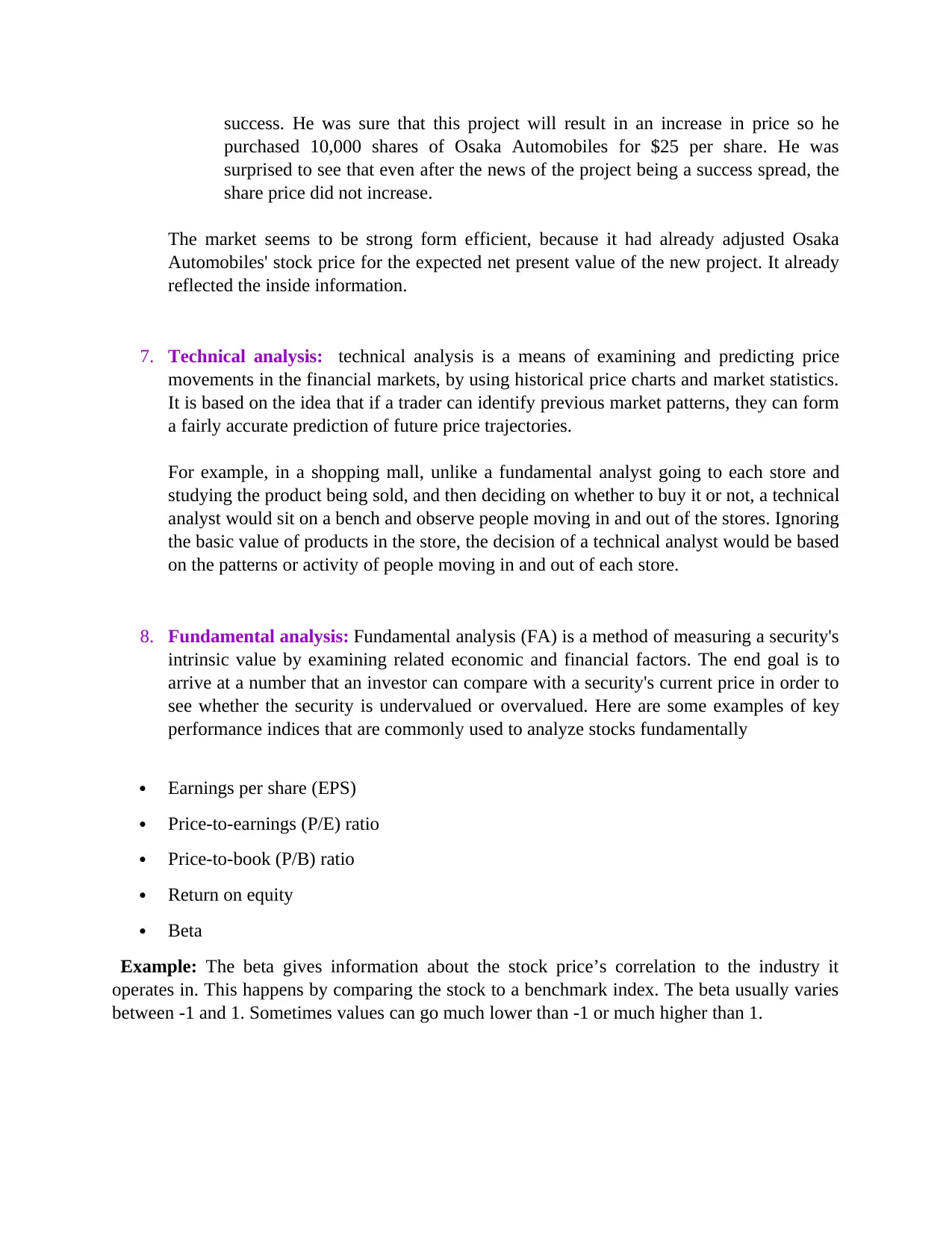
success. He was sure that this project will result in an increase in price so he
purchased 10,000 shares of Osaka Automobiles for $25 per share. He was
surprised to see that even after the news of the project being a success spread, the
share price did not increase.
The market seems to be strong form efficient, because it had already adjusted Osaka
Automobiles' stock price for the expected net present value of the new project. It already
reflected the inside information.
7. Technical analysis: technical analysis is a means of examining and predicting price
movements in the financial markets, by using historical price charts and market statistics.
It is based on the idea that if a trader can identify previous market patterns, they can form
a fairly accurate prediction of future price trajectories.
For example, in a shopping mall, unlike a fundamental analyst going to each store and
studying the product being sold, and then deciding on whether to buy it or not, a technical
analyst would sit on a bench and observe people moving in and out of the stores. Ignoring
the basic value of products in the store, the decision of a technical analyst would be based
on the patterns or activity of people moving in and out of each store.
8. Fundamental analysis: Fundamental analysis (FA) is a method of measuring a security's
intrinsic value by examining related economic and financial factors. The end goal is to
arrive at a number that an investor can compare with a security's current price in order to
see whether the security is undervalued or overvalued. Here are some examples of key
performance indices that are commonly used to analyze stocks fundamentally
Earnings per share (EPS)
Price-to-earnings (P/E) ratio
Price-to-book (P/B) ratio
Return on equity
Beta
Example: The beta gives information about the stock price’s correlation to the industry it
operates in. This happens by comparing the stock to a benchmark index. The beta usually varies
between -1 and 1. Sometimes values can go much lower than -1 or much higher than 1.
purchased 10,000 shares of Osaka Automobiles for $25 per share. He was
surprised to see that even after the news of the project being a success spread, the
share price did not increase.
The market seems to be strong form efficient, because it had already adjusted Osaka
Automobiles' stock price for the expected net present value of the new project. It already
reflected the inside information.
7. Technical analysis: technical analysis is a means of examining and predicting price
movements in the financial markets, by using historical price charts and market statistics.
It is based on the idea that if a trader can identify previous market patterns, they can form
a fairly accurate prediction of future price trajectories.
For example, in a shopping mall, unlike a fundamental analyst going to each store and
studying the product being sold, and then deciding on whether to buy it or not, a technical
analyst would sit on a bench and observe people moving in and out of the stores. Ignoring
the basic value of products in the store, the decision of a technical analyst would be based
on the patterns or activity of people moving in and out of each store.
8. Fundamental analysis: Fundamental analysis (FA) is a method of measuring a security's
intrinsic value by examining related economic and financial factors. The end goal is to
arrive at a number that an investor can compare with a security's current price in order to
see whether the security is undervalued or overvalued. Here are some examples of key
performance indices that are commonly used to analyze stocks fundamentally
Earnings per share (EPS)
Price-to-earnings (P/E) ratio
Price-to-book (P/B) ratio
Return on equity
Beta
Example: The beta gives information about the stock price’s correlation to the industry it
operates in. This happens by comparing the stock to a benchmark index. The beta usually varies
between -1 and 1. Sometimes values can go much lower than -1 or much higher than 1.
⊘ This is a preview!⊘
Do you want full access?
Subscribe today to unlock all pages.

Trusted by 1+ million students worldwide
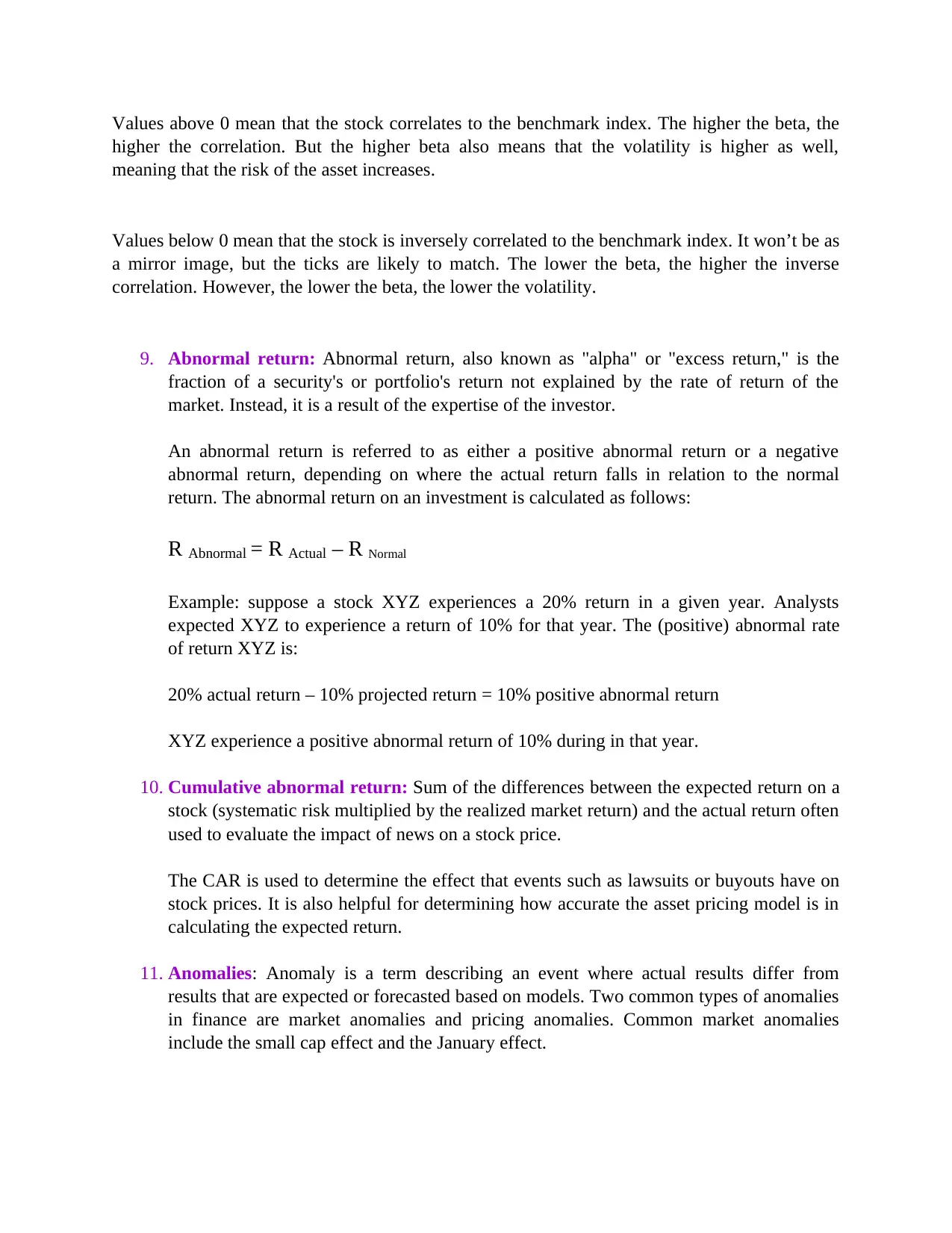
Values above 0 mean that the stock correlates to the benchmark index. The higher the beta, the
higher the correlation. But the higher beta also means that the volatility is higher as well,
meaning that the risk of the asset increases.
Values below 0 mean that the stock is inversely correlated to the benchmark index. It won’t be as
a mirror image, but the ticks are likely to match. The lower the beta, the higher the inverse
correlation. However, the lower the beta, the lower the volatility.
9. Abnormal return: Abnormal return, also known as "alpha" or "excess return," is the
fraction of a security's or portfolio's return not explained by the rate of return of the
market. Instead, it is a result of the expertise of the investor.
An abnormal return is referred to as either a positive abnormal return or a negative
abnormal return, depending on where the actual return falls in relation to the normal
return. The abnormal return on an investment is calculated as follows:
R Abnormal = R Actual – R Normal
Example: suppose a stock XYZ experiences a 20% return in a given year. Analysts
expected XYZ to experience a return of 10% for that year. The (positive) abnormal rate
of return XYZ is:
20% actual return – 10% projected return = 10% positive abnormal return
XYZ experience a positive abnormal return of 10% during in that year.
10. Cumulative abnormal return: Sum of the differences between the expected return on a
stock (systematic risk multiplied by the realized market return) and the actual return often
used to evaluate the impact of news on a stock price.
The CAR is used to determine the effect that events such as lawsuits or buyouts have on
stock prices. It is also helpful for determining how accurate the asset pricing model is in
calculating the expected return.
11. Anomalies: Anomaly is a term describing an event where actual results differ from
results that are expected or forecasted based on models. Two common types of anomalies
in finance are market anomalies and pricing anomalies. Common market anomalies
include the small cap effect and the January effect.
higher the correlation. But the higher beta also means that the volatility is higher as well,
meaning that the risk of the asset increases.
Values below 0 mean that the stock is inversely correlated to the benchmark index. It won’t be as
a mirror image, but the ticks are likely to match. The lower the beta, the higher the inverse
correlation. However, the lower the beta, the lower the volatility.
9. Abnormal return: Abnormal return, also known as "alpha" or "excess return," is the
fraction of a security's or portfolio's return not explained by the rate of return of the
market. Instead, it is a result of the expertise of the investor.
An abnormal return is referred to as either a positive abnormal return or a negative
abnormal return, depending on where the actual return falls in relation to the normal
return. The abnormal return on an investment is calculated as follows:
R Abnormal = R Actual – R Normal
Example: suppose a stock XYZ experiences a 20% return in a given year. Analysts
expected XYZ to experience a return of 10% for that year. The (positive) abnormal rate
of return XYZ is:
20% actual return – 10% projected return = 10% positive abnormal return
XYZ experience a positive abnormal return of 10% during in that year.
10. Cumulative abnormal return: Sum of the differences between the expected return on a
stock (systematic risk multiplied by the realized market return) and the actual return often
used to evaluate the impact of news on a stock price.
The CAR is used to determine the effect that events such as lawsuits or buyouts have on
stock prices. It is also helpful for determining how accurate the asset pricing model is in
calculating the expected return.
11. Anomalies: Anomaly is a term describing an event where actual results differ from
results that are expected or forecasted based on models. Two common types of anomalies
in finance are market anomalies and pricing anomalies. Common market anomalies
include the small cap effect and the January effect.
Paraphrase This Document
Need a fresh take? Get an instant paraphrase of this document with our AI Paraphraser
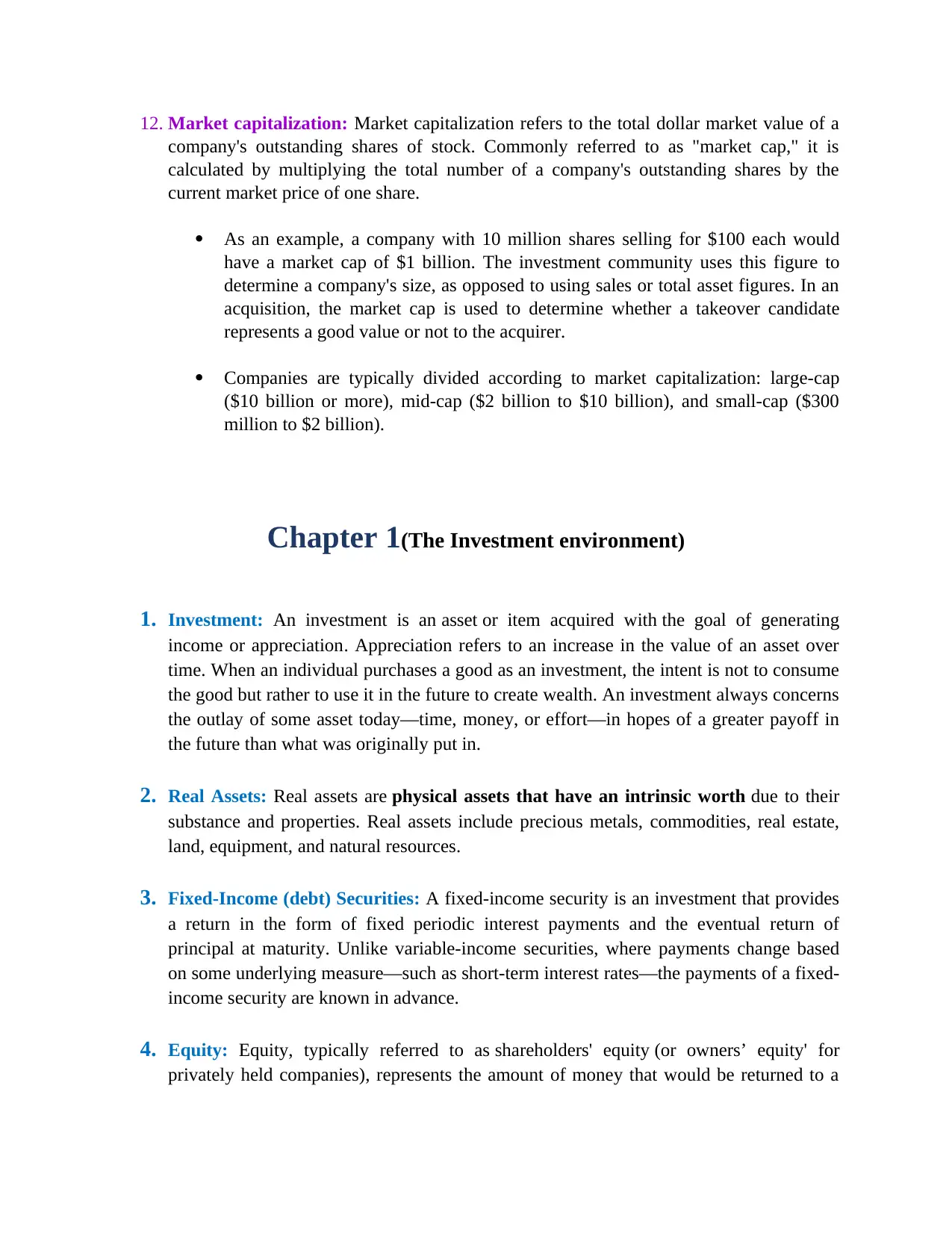
12. Market capitalization: Market capitalization refers to the total dollar market value of a
company's outstanding shares of stock. Commonly referred to as "market cap," it is
calculated by multiplying the total number of a company's outstanding shares by the
current market price of one share.
As an example, a company with 10 million shares selling for $100 each would
have a market cap of $1 billion. The investment community uses this figure to
determine a company's size, as opposed to using sales or total asset figures. In an
acquisition, the market cap is used to determine whether a takeover candidate
represents a good value or not to the acquirer.
Companies are typically divided according to market capitalization: large-cap
($10 billion or more), mid-cap ($2 billion to $10 billion), and small-cap ($300
million to $2 billion).
Chapter 1(The Investment environment)
1. Investment: An investment is an asset or item acquired with the goal of generating
income or appreciation. Appreciation refers to an increase in the value of an asset over
time. When an individual purchases a good as an investment, the intent is not to consume
the good but rather to use it in the future to create wealth. An investment always concerns
the outlay of some asset today—time, money, or effort—in hopes of a greater payoff in
the future than what was originally put in.
2. Real Assets: Real assets are physical assets that have an intrinsic worth due to their
substance and properties. Real assets include precious metals, commodities, real estate,
land, equipment, and natural resources.
3. Fixed-Income (debt) Securities: A fixed-income security is an investment that provides
a return in the form of fixed periodic interest payments and the eventual return of
principal at maturity. Unlike variable-income securities, where payments change based
on some underlying measure—such as short-term interest rates—the payments of a fixed-
income security are known in advance.
4. Equity: Equity, typically referred to as shareholders' equity (or owners’ equity' for
privately held companies), represents the amount of money that would be returned to a
company's outstanding shares of stock. Commonly referred to as "market cap," it is
calculated by multiplying the total number of a company's outstanding shares by the
current market price of one share.
As an example, a company with 10 million shares selling for $100 each would
have a market cap of $1 billion. The investment community uses this figure to
determine a company's size, as opposed to using sales or total asset figures. In an
acquisition, the market cap is used to determine whether a takeover candidate
represents a good value or not to the acquirer.
Companies are typically divided according to market capitalization: large-cap
($10 billion or more), mid-cap ($2 billion to $10 billion), and small-cap ($300
million to $2 billion).
Chapter 1(The Investment environment)
1. Investment: An investment is an asset or item acquired with the goal of generating
income or appreciation. Appreciation refers to an increase in the value of an asset over
time. When an individual purchases a good as an investment, the intent is not to consume
the good but rather to use it in the future to create wealth. An investment always concerns
the outlay of some asset today—time, money, or effort—in hopes of a greater payoff in
the future than what was originally put in.
2. Real Assets: Real assets are physical assets that have an intrinsic worth due to their
substance and properties. Real assets include precious metals, commodities, real estate,
land, equipment, and natural resources.
3. Fixed-Income (debt) Securities: A fixed-income security is an investment that provides
a return in the form of fixed periodic interest payments and the eventual return of
principal at maturity. Unlike variable-income securities, where payments change based
on some underlying measure—such as short-term interest rates—the payments of a fixed-
income security are known in advance.
4. Equity: Equity, typically referred to as shareholders' equity (or owners’ equity' for
privately held companies), represents the amount of money that would be returned to a
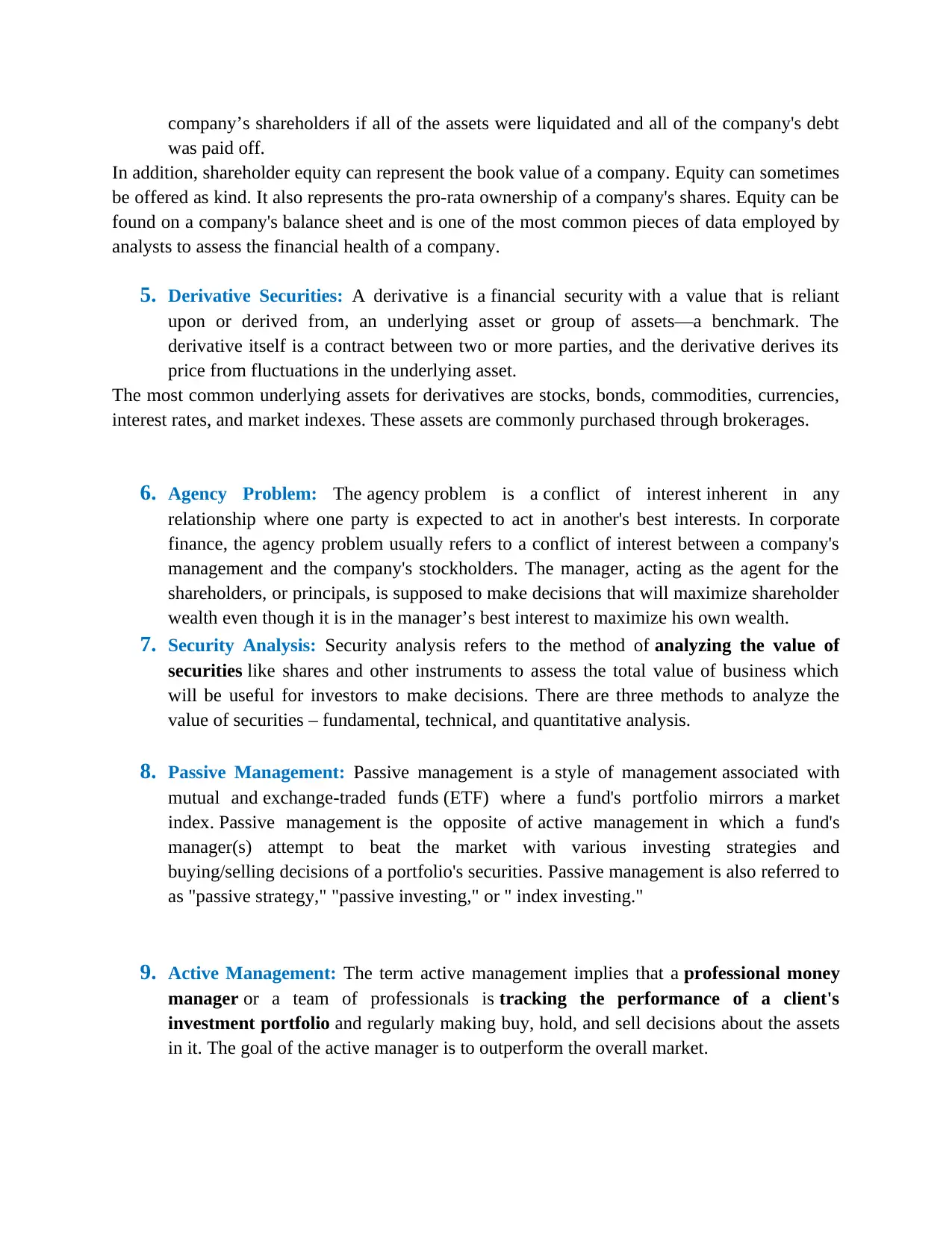
company’s shareholders if all of the assets were liquidated and all of the company's debt
was paid off.
In addition, shareholder equity can represent the book value of a company. Equity can sometimes
be offered as kind. It also represents the pro-rata ownership of a company's shares. Equity can be
found on a company's balance sheet and is one of the most common pieces of data employed by
analysts to assess the financial health of a company.
5. Derivative Securities: A derivative is a financial security with a value that is reliant
upon or derived from, an underlying asset or group of assets—a benchmark. The
derivative itself is a contract between two or more parties, and the derivative derives its
price from fluctuations in the underlying asset.
The most common underlying assets for derivatives are stocks, bonds, commodities, currencies,
interest rates, and market indexes. These assets are commonly purchased through brokerages.
6. Agency Problem: The agency problem is a conflict of interest inherent in any
relationship where one party is expected to act in another's best interests. In corporate
finance, the agency problem usually refers to a conflict of interest between a company's
management and the company's stockholders. The manager, acting as the agent for the
shareholders, or principals, is supposed to make decisions that will maximize shareholder
wealth even though it is in the manager’s best interest to maximize his own wealth.
7. Security Analysis: Security analysis refers to the method of analyzing the value of
securities like shares and other instruments to assess the total value of business which
will be useful for investors to make decisions. There are three methods to analyze the
value of securities – fundamental, technical, and quantitative analysis.
8. Passive Management: Passive management is a style of management associated with
mutual and exchange-traded funds (ETF) where a fund's portfolio mirrors a market
index. Passive management is the opposite of active management in which a fund's
manager(s) attempt to beat the market with various investing strategies and
buying/selling decisions of a portfolio's securities. Passive management is also referred to
as "passive strategy," "passive investing," or " index investing."
9. Active Management: The term active management implies that a professional money
manager or a team of professionals is tracking the performance of a client's
investment portfolio and regularly making buy, hold, and sell decisions about the assets
in it. The goal of the active manager is to outperform the overall market.
was paid off.
In addition, shareholder equity can represent the book value of a company. Equity can sometimes
be offered as kind. It also represents the pro-rata ownership of a company's shares. Equity can be
found on a company's balance sheet and is one of the most common pieces of data employed by
analysts to assess the financial health of a company.
5. Derivative Securities: A derivative is a financial security with a value that is reliant
upon or derived from, an underlying asset or group of assets—a benchmark. The
derivative itself is a contract between two or more parties, and the derivative derives its
price from fluctuations in the underlying asset.
The most common underlying assets for derivatives are stocks, bonds, commodities, currencies,
interest rates, and market indexes. These assets are commonly purchased through brokerages.
6. Agency Problem: The agency problem is a conflict of interest inherent in any
relationship where one party is expected to act in another's best interests. In corporate
finance, the agency problem usually refers to a conflict of interest between a company's
management and the company's stockholders. The manager, acting as the agent for the
shareholders, or principals, is supposed to make decisions that will maximize shareholder
wealth even though it is in the manager’s best interest to maximize his own wealth.
7. Security Analysis: Security analysis refers to the method of analyzing the value of
securities like shares and other instruments to assess the total value of business which
will be useful for investors to make decisions. There are three methods to analyze the
value of securities – fundamental, technical, and quantitative analysis.
8. Passive Management: Passive management is a style of management associated with
mutual and exchange-traded funds (ETF) where a fund's portfolio mirrors a market
index. Passive management is the opposite of active management in which a fund's
manager(s) attempt to beat the market with various investing strategies and
buying/selling decisions of a portfolio's securities. Passive management is also referred to
as "passive strategy," "passive investing," or " index investing."
9. Active Management: The term active management implies that a professional money
manager or a team of professionals is tracking the performance of a client's
investment portfolio and regularly making buy, hold, and sell decisions about the assets
in it. The goal of the active manager is to outperform the overall market.
⊘ This is a preview!⊘
Do you want full access?
Subscribe today to unlock all pages.

Trusted by 1+ million students worldwide
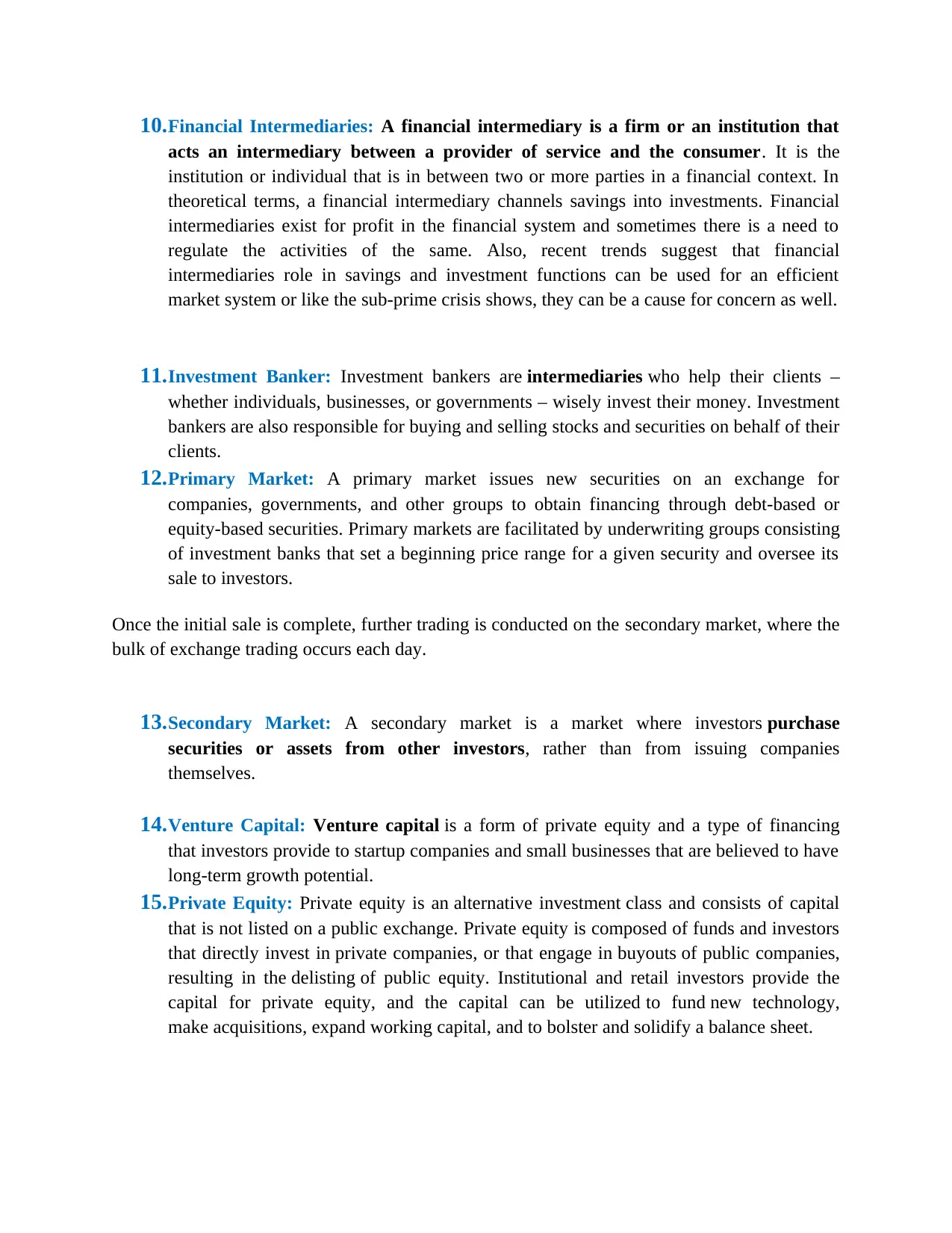
10.Financial Intermediaries: A financial intermediary is a firm or an institution that
acts an intermediary between a provider of service and the consumer. It is the
institution or individual that is in between two or more parties in a financial context. In
theoretical terms, a financial intermediary channels savings into investments. Financial
intermediaries exist for profit in the financial system and sometimes there is a need to
regulate the activities of the same. Also, recent trends suggest that financial
intermediaries role in savings and investment functions can be used for an efficient
market system or like the sub-prime crisis shows, they can be a cause for concern as well.
11.Investment Banker: Investment bankers are intermediaries who help their clients –
whether individuals, businesses, or governments – wisely invest their money. Investment
bankers are also responsible for buying and selling stocks and securities on behalf of their
clients.
12.Primary Market: A primary market issues new securities on an exchange for
companies, governments, and other groups to obtain financing through debt-based or
equity-based securities. Primary markets are facilitated by underwriting groups consisting
of investment banks that set a beginning price range for a given security and oversee its
sale to investors.
Once the initial sale is complete, further trading is conducted on the secondary market, where the
bulk of exchange trading occurs each day.
13.Secondary Market: A secondary market is a market where investors purchase
securities or assets from other investors, rather than from issuing companies
themselves.
14.Venture Capital: Venture capital is a form of private equity and a type of financing
that investors provide to startup companies and small businesses that are believed to have
long-term growth potential.
15.Private Equity: Private equity is an alternative investment class and consists of capital
that is not listed on a public exchange. Private equity is composed of funds and investors
that directly invest in private companies, or that engage in buyouts of public companies,
resulting in the delisting of public equity. Institutional and retail investors provide the
capital for private equity, and the capital can be utilized to fund new technology,
make acquisitions, expand working capital, and to bolster and solidify a balance sheet.
acts an intermediary between a provider of service and the consumer. It is the
institution or individual that is in between two or more parties in a financial context. In
theoretical terms, a financial intermediary channels savings into investments. Financial
intermediaries exist for profit in the financial system and sometimes there is a need to
regulate the activities of the same. Also, recent trends suggest that financial
intermediaries role in savings and investment functions can be used for an efficient
market system or like the sub-prime crisis shows, they can be a cause for concern as well.
11.Investment Banker: Investment bankers are intermediaries who help their clients –
whether individuals, businesses, or governments – wisely invest their money. Investment
bankers are also responsible for buying and selling stocks and securities on behalf of their
clients.
12.Primary Market: A primary market issues new securities on an exchange for
companies, governments, and other groups to obtain financing through debt-based or
equity-based securities. Primary markets are facilitated by underwriting groups consisting
of investment banks that set a beginning price range for a given security and oversee its
sale to investors.
Once the initial sale is complete, further trading is conducted on the secondary market, where the
bulk of exchange trading occurs each day.
13.Secondary Market: A secondary market is a market where investors purchase
securities or assets from other investors, rather than from issuing companies
themselves.
14.Venture Capital: Venture capital is a form of private equity and a type of financing
that investors provide to startup companies and small businesses that are believed to have
long-term growth potential.
15.Private Equity: Private equity is an alternative investment class and consists of capital
that is not listed on a public exchange. Private equity is composed of funds and investors
that directly invest in private companies, or that engage in buyouts of public companies,
resulting in the delisting of public equity. Institutional and retail investors provide the
capital for private equity, and the capital can be utilized to fund new technology,
make acquisitions, expand working capital, and to bolster and solidify a balance sheet.
Paraphrase This Document
Need a fresh take? Get an instant paraphrase of this document with our AI Paraphraser
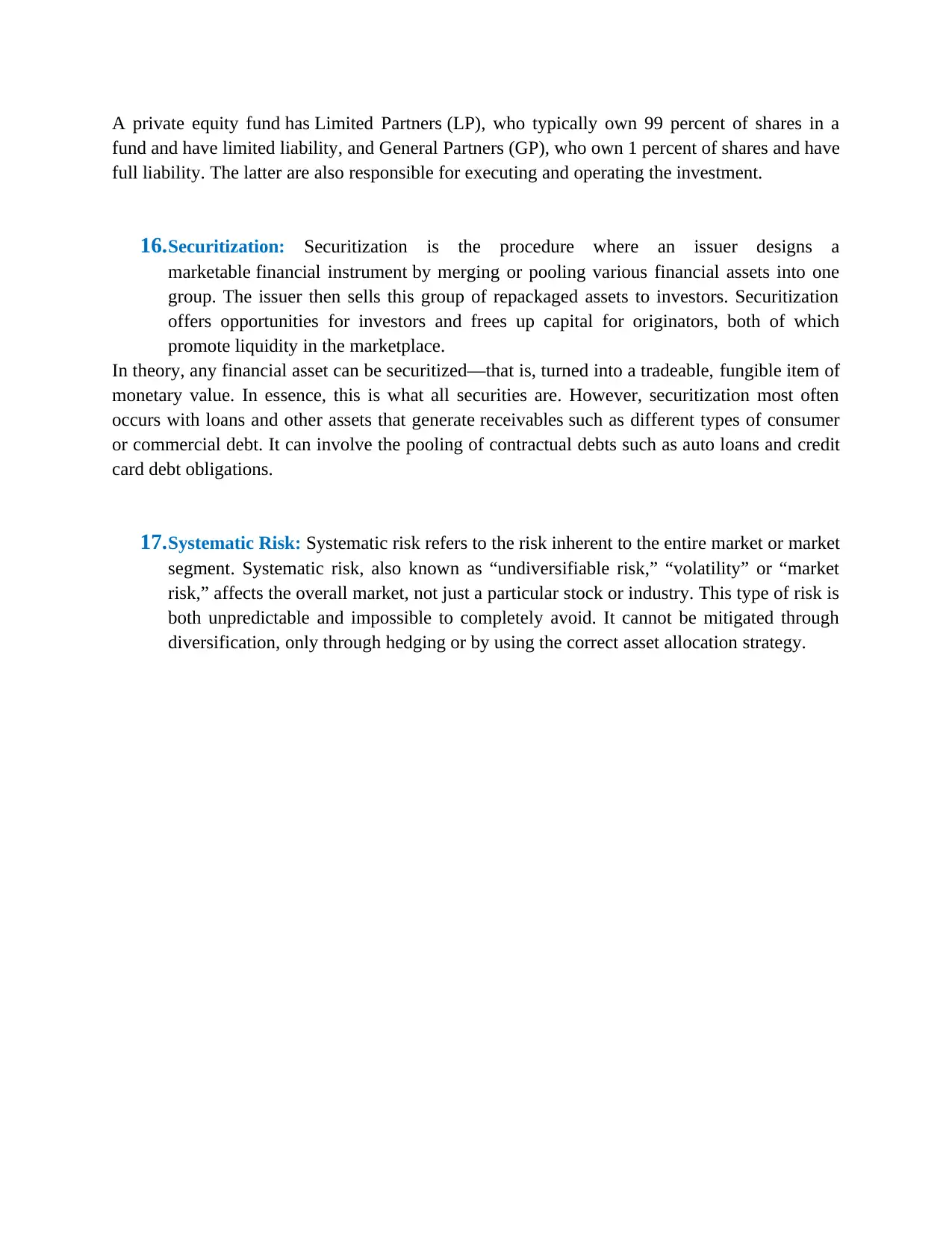
A private equity fund has Limited Partners (LP), who typically own 99 percent of shares in a
fund and have limited liability, and General Partners (GP), who own 1 percent of shares and have
full liability. The latter are also responsible for executing and operating the investment.
16.Securitization: Securitization is the procedure where an issuer designs a
marketable financial instrument by merging or pooling various financial assets into one
group. The issuer then sells this group of repackaged assets to investors. Securitization
offers opportunities for investors and frees up capital for originators, both of which
promote liquidity in the marketplace.
In theory, any financial asset can be securitized—that is, turned into a tradeable, fungible item of
monetary value. In essence, this is what all securities are. However, securitization most often
occurs with loans and other assets that generate receivables such as different types of consumer
or commercial debt. It can involve the pooling of contractual debts such as auto loans and credit
card debt obligations.
17.Systematic Risk: Systematic risk refers to the risk inherent to the entire market or market
segment. Systematic risk, also known as “undiversifiable risk,” “volatility” or “market
risk,” affects the overall market, not just a particular stock or industry. This type of risk is
both unpredictable and impossible to completely avoid. It cannot be mitigated through
diversification, only through hedging or by using the correct asset allocation strategy.
fund and have limited liability, and General Partners (GP), who own 1 percent of shares and have
full liability. The latter are also responsible for executing and operating the investment.
16.Securitization: Securitization is the procedure where an issuer designs a
marketable financial instrument by merging or pooling various financial assets into one
group. The issuer then sells this group of repackaged assets to investors. Securitization
offers opportunities for investors and frees up capital for originators, both of which
promote liquidity in the marketplace.
In theory, any financial asset can be securitized—that is, turned into a tradeable, fungible item of
monetary value. In essence, this is what all securities are. However, securitization most often
occurs with loans and other assets that generate receivables such as different types of consumer
or commercial debt. It can involve the pooling of contractual debts such as auto loans and credit
card debt obligations.
17.Systematic Risk: Systematic risk refers to the risk inherent to the entire market or market
segment. Systematic risk, also known as “undiversifiable risk,” “volatility” or “market
risk,” affects the overall market, not just a particular stock or industry. This type of risk is
both unpredictable and impossible to completely avoid. It cannot be mitigated through
diversification, only through hedging or by using the correct asset allocation strategy.
1 out of 8
Related Documents
Your All-in-One AI-Powered Toolkit for Academic Success.
+13062052269
info@desklib.com
Available 24*7 on WhatsApp / Email
![[object Object]](/_next/static/media/star-bottom.7253800d.svg)
Unlock your academic potential
Copyright © 2020–2025 A2Z Services. All Rights Reserved. Developed and managed by ZUCOL.





